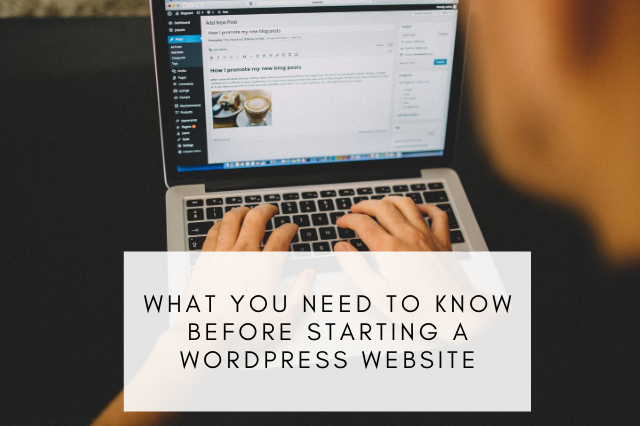What You Need to Know Before Starting a WordPress Website

WordPress is the most popular website building platform with over 27+ million users, and for good reason. It’s easy and simple to use, and you can find many add-ons and plug-ins for doing most things you’d want a website for, whether it’s showing off your art portfolio, or creating an eCommerce shopping cart. There are some tips and things you should know before starting a WordPress website and this particular article we will focus on those tips specially.
However, WordPress isn’t as simple as 1-2-3, there’s a lot that goes into building a nice WordPress site that impresses visitors. In this article, we’re going to go over a few helpful tips and things you should know before starting a WordPress website.
Do you need to know the code?
Many people wonder that you need to know coding skills for building a WordPress website, and there are some great articles on the topic. Without getting into too many details here, you don’t need to know any coding to build a WordPress site, using templates and WYSIWYG editing.
However, most aspects of customizing your website design involve CSS, and even installing a custom theme may require a little bit of CSS tinkering. If you want to create a stunning WordPress website design like the examples found on this page, you’ll need a bit of CSS and maybe even JavaScript knowledge.
So while you don’t need any CSS programming knowledge to start a WordPress website, having a little bit helps.
Choosing a domain name
Your domain name is incredibly important, but if you’re launching a small online business, it can be difficult choosing a good domain name. Many websites either use a branded domain name or a domain name that contains keywords relevant to what the business is about.
For example, Spotify is a streaming music service, but their domain isn’t Streaming-Music-Service.com, because people already recognize the Spotify brand.
A problem with keyword-based domains is, for example, let’s say you plan to sell men’s shoes, of course, obvious keyword-based domain names like mens-shoes.com will already be taken. Also, keyword-stuffed domain names tend to make a website look spammy.
A good approach is to consider the future of your brand and plan for scaling. Thus, it’s actually advisable to try and go with a brand domain, and build your brand as you go along, even if your domain name doesn’t explicitly tell people you sell men’s shoes.
You can focus on SEO for men’s shoes as you build your website, and that will be far more beneficial to getting organic search traffic than a keyword-stuffed domain name.
Mobile design is key
As around 67% of global web traffic is from mobile devices, having a website that follows mobile design practices is in your best interest. Google re-designed their crawler bots to be “mobile-first” a couple of years ago, which means that Google prefers to visit the mobile version of your website for search indexing.
This was big news because it means that you could have a perfect desktop website, but if your mobile design was poor, Google would penalize you in search engine rankings.
Get an SEO plugin
SEO (search engine optimization) is one of the most important parts of website building and marketing. The higher you rank in search engines, the more organic traffic you’ll get, instead of needing to spend money on lots of advertisement campaigns.
SEO isn’t simply something you do after your website is built, like writing blog articles with SEO-friendly keywords. SEO is something that needs to be considered from the beginning of the website design process, so you can structure your website around SEO and customer funneling strategies.
Fortunately, some great SEO plugins can help you optimize your website during the building phase, such as Yoast, Rank Math, or SEOPress.
Use an HTML cleaner when writing posts in Word
Using the built-in WordPress editor is fairly simple, but many of us still prefer to use document software like MS Word, then copypasting the article into WordPress for publishing.
The problem here is that a lot of Word’s formatting doesn’t paste well into WordPress, and if you look at the text-editor in WordPress instead of the visual editor, you’ll see a lot of extra HTML code from MS Word that confuses WordPress.
A good trick is after you’ve written an article in MS Word, copy-paste it into HTML-Cleaner.com, click the “Clean HTML” button, and copy the resulting HTML back into WordPress. Your formatting in the WordPress editor will be a lot closer to what you originally had in MS Word.
Convert images to WebP
Your site must load fast, for both search engine crawlers and human visitors. One thing that can slow down your page loading times is large images.
Google created the WebP format, which is a lossy compression algorithm that reduces the file size of your images, without any loss in image quality. It’s easy to convert your images to WebP format, there are a lot of tools for doing it online in batches.
These are some beneficial and helpful tips you have to Know Before Starting a WordPress Website. I hope you liked the article.
You can also check How to Choose Perfect Theme for Your WordPress Website.
